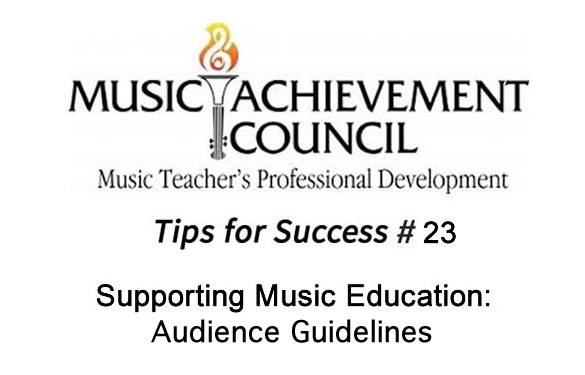Supporting Music Education:
Audience Guidelines
Becoming a discerning, supportive and knowledgeable audience member
is an important part of a student’s education. Successful audience
participation requires skill, discretion, common sense, discipline and a bit
of knowledge.
You have worked very hard to prepare your students to perform in concert. One final step remains: It is also essential that you set a high expectation for audience behavior and appropriate participation.
- Most of us learn to be “an audience” in front of the television or at the movies. This is quite different from actually being present in a room with other people – most likely, people you don’t know and who don’t know you – at a live performance. At live performances, we enter into relationships, both with the performers and with our fellow audience members.
- One of the pleasures of live performance is spontaneity, but what is required of an audience is spontaneity within certain discreet boundaries.
- Appropriate performance behaviors change according to the type of performance we are attending. When we comment on a performance, we are not only voicing our opinions, but also revealing our knowledge or lack of knowledge.
Choose from the appropriate event information below and consider including it in your program.
At Live Performances
- Be amazed, impressed, challenged, fascinated and appreciative.
- Applaud when the performers walk onstage and at the end of the piece but not in the middle. Look at the printed program: Some pieces consist of several “movements.” It is customary to wait in silence between these movements and then to applaud at the end of the entire piece.
- Refrain from talking during the performance. The performers and our fellow audience members are trying to concentrate. The medium is sound, and unwanted sound competes with the performance.
Show appreciation through applause. Cheering is not appropriate at a live concert. - Refrain from taking flash photos or making video or audio recordings. Flash photos disrupt the performers, and copyright laws prohibit recordings of any sort.
In Addition, at a Jazz Concert
Get excited!
Applaud a solo that you find particularly great. You may
show appreciation in the middle of a piece.
Express yourself more openly than at a classical concert,
but remember that cheering is still not appropriate.
In Addition, at a Dance Concert
- Be amazed and fascinated with the movement of the
human body. - Applaud anywhere in the midst of the dance. You may
applaud a particularly difficult or well-executed move,
step or leap.
At a Visual Arts Event
- Examine, ogle, question, speak with the artist, scrutinize,
be baffled, converse, melt, raise your eyebrows – but also
show respect for the creative process. - Refrain from touching unless specifically asked.
- You may ask permission from the artist to take
photographs.
At the Theatre
- Be fascinated, cry, laugh, get angry and smile.
- Applaud at the end of a scene, act, speech or zinger. In
other words, you may respond in the middle of the piece. - Refrain from talking and taking flash photos or making
recordings. - Don’t distract the performers before, during or after the
performance.
At a Poetry or Fiction Reading
- Listen in silence. Cultivate the ability to let the words play
on your imagination. Let the voice of the reader and his or
her language conjure up images in your mind’s eye. - If a poet is reading more than one poem, he or she will
tell you this at the beginning of the reading. Do not
applaud until all of the poems have been read.
And Finally
- Standing ovations are rare in the real world. Be judicious
with your standing ovations. They should not become so
commonplace that performers who receive only warm
applause fear that the audience disapproves of their
performance.
Informances
- Informances (opportunities where the audience
gains information about an arts discipline while at a
performance) are extremely effective advocacy tools.
Informances can be one number in a program or an entire
production. - Build opportunities for the audience to actively participate
(sing, move, emulate, play, etc.) in them. - Encourage the audience to look at the process of creating,
not just the product. It is through “process” that students
become enriched through the arts.


